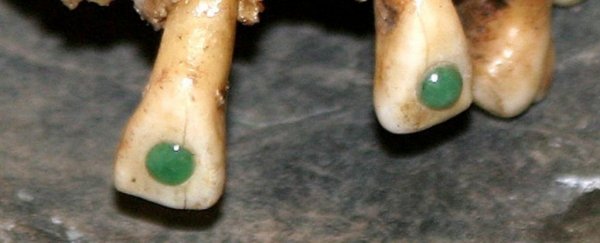The ancient Maya once took enormous pride in their teeth. Long before Europeans were filling their cavities with gold, people in Mesoamerica were flashing grins bedazzled with jade, turquoise, gold, jet, or hematite gems.
Male or female, rich or poor, it appears many individuals visited the dentist as young adults to have their teeth drilled and filled with jewels, precious stones, or minerals.
The inlays would have lasted a lifetime and likely had spiritual meaning. But dental bling at this time may not have been purely aesthetic.
New research on the cement used to glue gems to Maya teeth has highlighted a few potential hygienic and therapeutic properties.
Not only was the sealant incredibly adhesive (holding the gem in place for more than a thousand years), its ingredients have the potential to fight tooth decay, and reduce inflammation and infection in the mouth.
The rich blend of organic components has archaeologists thinking the cement-like substance was not merely used as a water-repelling glue.
Instead, the attachment of small stones to incisors and canines during early adulthood might have been accompanied by some protection against cavities.
The drilling to insert these gems into the tooth was done so expertly, it rarely impacted the pulp of nerves and blood vessels at the center.
 Ancient Maya teeth analyzed in the study. (Hernández-Bolio et al., Journal of Archaeological Science, 2022)
Ancient Maya teeth analyzed in the study. (Hernández-Bolio et al., Journal of Archaeological Science, 2022)
The ancient teeth analyzed in the study came from three Maya archaeological sites in Guatemala, Belize and Honduras, and the individuals the teeth belonged to did not appear to be from elite backgrounds.
In the sealants used to attach gems to the teeth, researchers identified 150 organic molecules that are commonly found in plant resins. Depending on where the tooth came from on the Yucatan peninsula, each sealant blend had a slightly different ingredient list, but the main ingredients were largely the same.
Most dental cements showed compounds associated with pine tree tar, thought to contain antibacterial-like properties. Two of the eight teeth held remnants of sclareolide, a plant compound with antibacterial and antifungal properties. It's also often used in the perfume industry, as it smells quite nice.
Essential oils from plants in the mint family were also common in the sealants, suggesting potential anti-inflammatory effects.
The findings are not entirely unexpected. There are many lines of evidence that suggest dental hygiene was taken seriously by the ancient Maya. People in this civilization regularly polished their teeth, and if decay set in, teeth appear to have been extracted.
These more therapeutic practices to dentistry, however, have been historically overshadowed by the flashier decorations of the time. The edges of Maya teeth are often filed into pointy shapes, and then inlaid with gems. In the past, this has been pinned to ritual or aesthetic reasons only.
Maya dentistry was clearly an art form, but the new findings suggest the extensive use of tooth modifications might have been about more than just beauty.
The fact that lots of people were getting the treatment done also suggests it is not necessarily a reflection of the person's social status.
"While the blends were both complex and effective in providing long-lasting dental obturations, the mortuary contexts of the individuals sampled indicate these were not elite individuals but that instead, a broad swathe of Maya society benefited from the expertise of the individuals who manufactured these cements," the authors write.
The study was published in the Journal of Archaeological Science: Reports.
